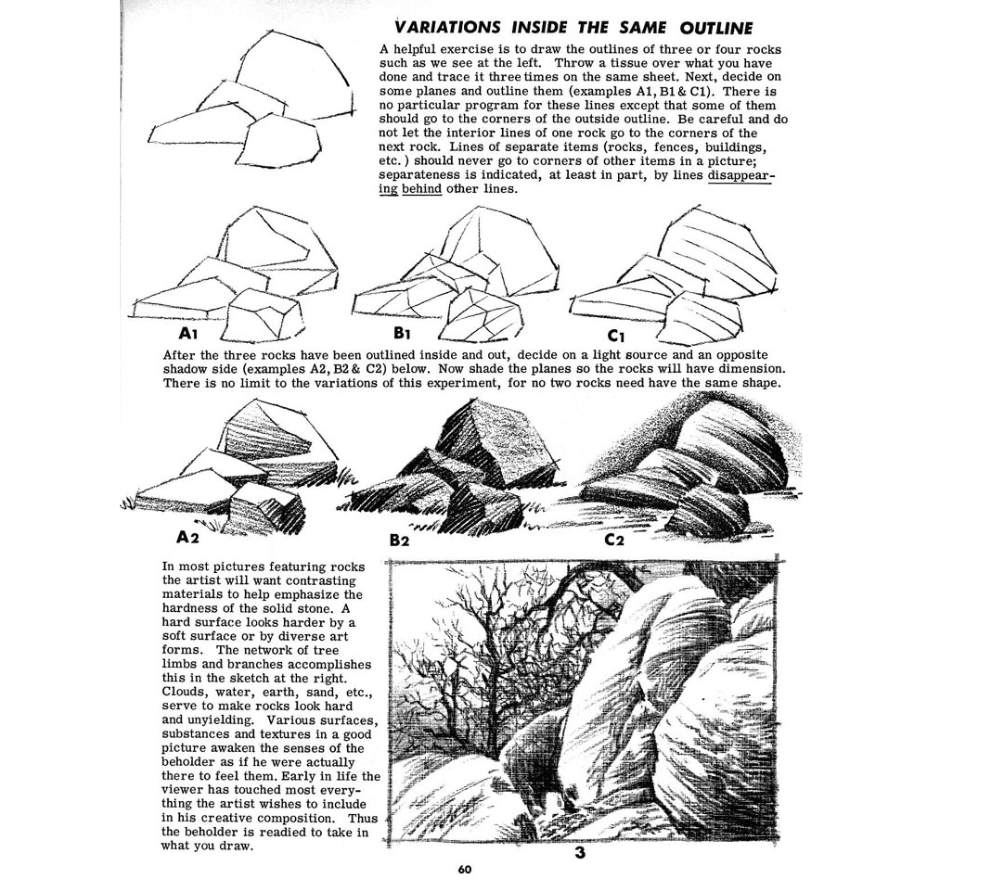Variations Inside the Same Outline Description

The image, titled “Variations Inside the Same Outline,” is an instructional guide for artists, likely from a drawing or illustration textbook (Page 60), focusing on creating variety within a fixed outline of rocks. It emphasizes the importance of shading, texture, and internal details to differentiate objects while maintaining the same external shape. The layout is structured into two main sections: an introductory explanation with initial sketches at the top, and three detailed examples of rock variations (A2, B2, C2) at the bottom, each accompanied by descriptive text. This guide is a valuable resource for artists aiming to enhance their ability to depict natural forms with depth and character.

Introductory Explanation and Initial Sketches
The top section provides a conceptual overview and initial sketches labeled A1, B1, and C1, illustrating the process of working within a fixed outline:
- Text Explanation: The text advises artists to outline three or four rocks and treat them as a single unit over time, as shown in examples A1, B1, and C1. It emphasizes that there’s no universal program for the internal lines of these examples; instead, artists should focus on lines that separate elements (e.g., rocks, fences, buildings) and ensure they don’t go to the corners of the outline. Lines of separate items (e.g., other rocks in a picture) should not go to corners, and separateness should be indicated, at least in part, by lines disappearing. This technique creates a sense of depth and distinction within the same outline.
- Sketches A1, B1, C1: These sketches show three rocks outlined both inside and out, with a light source and opposite shadow side (examples A2, B2, C2 are detailed below). The sketches are simple, with basic shading to indicate light direction, setting the stage for the more detailed variations.
Detailed Examples of Rock Variations
The bottom section showcases three variations (A2, B2, C2) of the rocks within the same outline, each with distinct textures and internal details, accompanied by descriptive text:
- A2 (Solid Stone): This rock is depicted with a hard, solid surface, as if carved from a single piece of stone. The texture is smooth with minimal cracks, and the shading emphasizes its solidity. The text notes that such rocks appeal to the artist for their hardness, contrasting with softer materials, and are often seen in landscapes with minimal vegetation.
- B2 (Tree Limbs and Branches): This rock features a network of tree limbs and branches integrated into its form. The texture is rough, with lines suggesting bark and organic growth. The text describes how these elements add a natural complexity, often seen in environments where rocks and vegetation coexist, such as forests or riverbanks.
- C2 (Soft, Undulating Surfaces): This rock has a softer, more undulating surface, resembling weathered or eroded stone. The texture includes smooth curves and subtle cracks, with shading that enhances its rounded, organic shape. The text explains that such rocks awaken a sense of beholder curiosity, often found in landscapes with water, sand, or other erosive forces, and their softness contrasts with harder rocks, adding variety to the scene.
Connection to Previous Guides
This tutorial on rock variations complements the earlier posts in your series by continuing the theme of skill-building and precision across disciplines:
- Woodworking, Measuring, and Welding Tools: The focus on texture and form in drawing rocks parallels the attention to material properties in woodworking (e.g., choosing the right wood grain with a tape measure), measuring (e.g., ensuring precise angles with a protractor), and welding (e.g., using a grinder to shape metal surfaces). The concept of varying textures within a fixed outline also mirrors the precision needed in crafting.
- Pterosaur Fossil: The detailed rendering of rocks with specific textures echoes the scientific illustration of pterosaur bones, where understanding form and surface detail is crucial for accurate depiction.
- Drawing Tutorials (JeYRam, Loomis, Shozart, Flames): This guide builds on the artistic foundation established in previous drawing lessons. JeYRam’s dresser drawing introduced combining shapes, Loomis and Shozart focused on head construction, and the flame tutorial taught dynamic organic forms. This rock tutorial extends these skills to natural forms, teaching artists how to create variety within a constrained outline, a skill that enhances their ability to depict landscapes and environments realistically.
Educational Value and Context
This guide, likely from a classic drawing textbook (Page 60), is a timeless resource for artists learning to depict natural forms with depth and variety. The emphasis on shading, texture, and internal lines within a fixed outline teaches a fundamental principle of illustration: creating visual interest through variation. The detailed examples (A2, B2, C2) provide practical applications, showing how different textures can evoke distinct characteristics in rocks, a skill that’s essential for landscape and environmental art.
Captured as of 08:29 AM EDT on Friday, June 06, 2025, this tutorial adds a natural dimension to your collection, bridging artistic techniques with the observational skills seen in scientific illustration and the precision of crafting.
